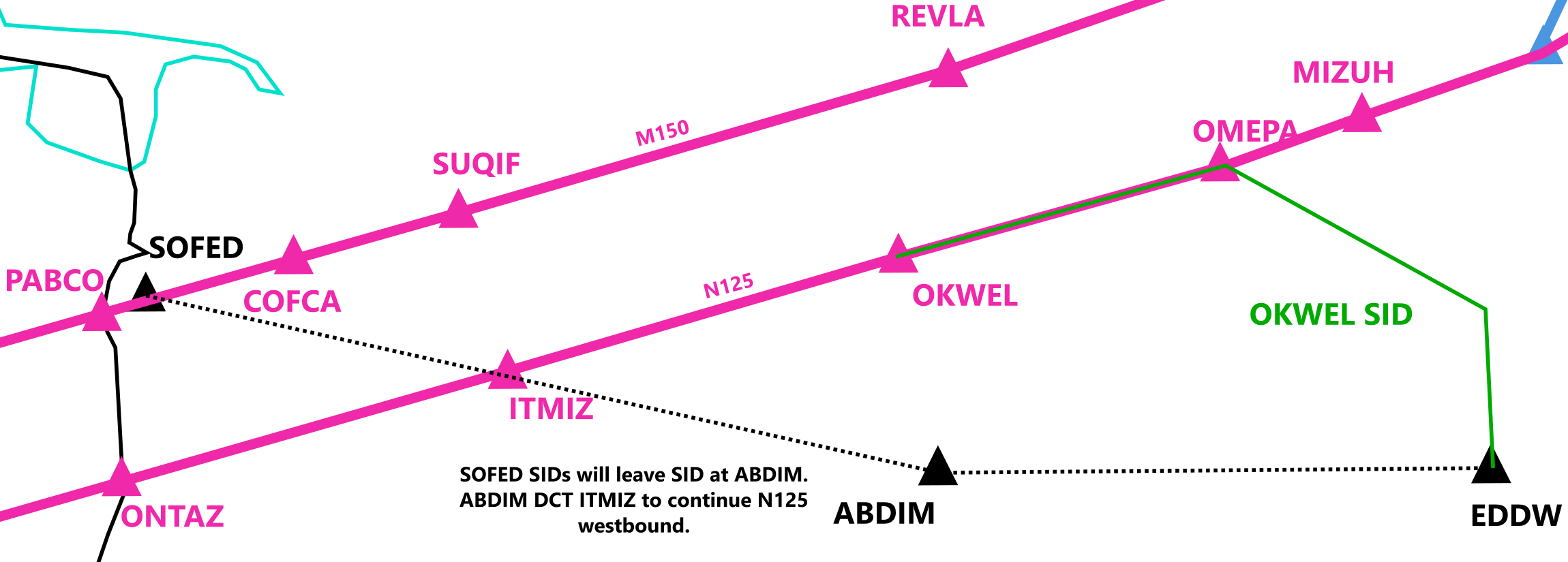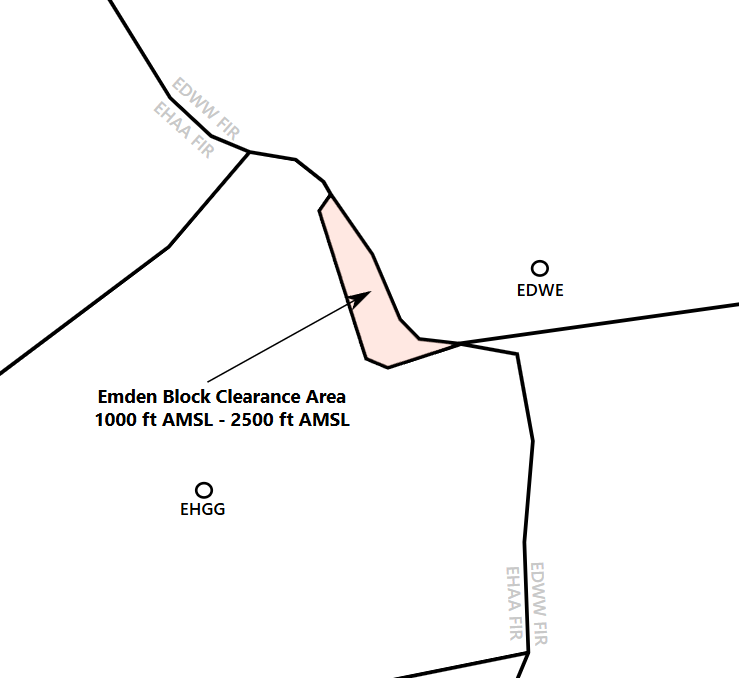| **Station** | **Station ID** | **Frequency** | **Login** |
| Friesland | FRI | 124.800 | EDDW\_APP |
Note: Unless otherwise coordinated, traffic has to exactly proceed on the listed routes. Shortcuts through the TRA are not allowed.
Sector FRI shall inform Bremen Ground/Tower about the activity of TRA Weser. During the activity of ED-R 202A, 202B or 202E all SOFED departures shall not be used. Traffic shall be routed via OKWEL N125 ITMIZ instead.
[](https://knowledgebase.vatsim-germany.org/uploads/images/gallery/2024-10/tra-wesrer.png) ### TRA Friesland Within the northern part of sector FRI, parts of TRA Friesland may be active from FL80-FL245. Traffic is generally not approved to cross ED-R 201A and ED-R201C. Traffic may cross ED-R 201B on the following priority routes (see box below):Note: Unless otherwise coordinated, traffic has to exactly proceed on the listed routes. Shortcuts through the TRA are not allowed.
| **Runway** | **Available Approach Types** | **Intercept Altitude** |
| 09/27 | ILS Z, LOC Z, RNP, VOR | 3000 ft |
| ILS Y | 1700 ft (as published) |
| **Conditions** | **Target Spacing** |
| Normal Operations | 6 NM (\*) |
| After coordination with Tower | 3 NM |
| During Low Visibility Conditions | 10 NM |
(\*) Behind a Beluga XL (A337) landing on runway 27, Bremen Radar shall increase the target spacing as a backtrack is required to vacate the runway via taxiway C due to wing span limitation. The normal Beluga (A3ST) is not affected from this.
## Departing Traffic from EDDW Departing traffic from EDDW shall automatically switch frequency from Tower to EDWW. Traffic transferred to EDWW ACC sectors according to [LOP EDWW](https://knowledgebase.vatsim-germany.org/books/bremen-fir-edww/page/lop-bremen-acc). Often traffic may be coordinated on a higher flight level with sector ALR, EID or EMS to avoid unnecessary level-offs. #### Special Procedure - SOFED SIDs Beginning on March 20, 2025, the SOFED SIDs are no longer connected to airway N125 due to changes to the ATS routes. Nevertheless, SOFED SIDs will still be used for departures to the west. Traffic intending to use SOFED SIDs is requested to file "ABDIM DCT ITMIZ N125 ..." as the initial segment of the F-Plan route. Traffic will then be instructed to follow a SOFED SID and to then join ITMIZ when reaching ABDIM located on the SID. [](https://knowledgebase.vatsim-germany.org/uploads/images/gallery/2025-03/inkscape-owgoufmqnj.png)It is to be expected that some pilots will file flight plans with the first waypoint "SOFED" instead of "ABDIM". This will still be considered as valid and Bremen Ground may clear SOFED SIDs nonetheless. Additionally, traffic may not follow the short cut to ITMIZ as instructed by Bremen Ground. It is highly recommended to coordinate shortcuts with sector Ems and Eider, especially when the route looks invalid.
## VFR Traffic ### VFR DeparturesJet aircraft or any aircraft with an MTOM of more than 5700 kg shall follow a published IFR departure route under VFR conditions.
By default, the Bremen Tower will instruct the aircraft to stay clear of airspace class D (non-CTR). Nevertheless, coordination may be required between Bremen Tower and Bremen Radar in case the pilots request further climb. In this case, Bremen Radar shall issue the approval to enter airspace D (non-CTR) to Bremen Tower directly. ### VFR ArrivalsJet aircraft or any aircraft with an MTOM of more than 5700 kg shall follow published IFR arrival routes under VFR conditions.
In this case, the arriving VFR traffic shall contact Bremen Radar latest 25 NM before approaching EDDW. Bremen Radar shall provide service for a practice approach VFR (e.g. via an ILS approach). An entry via published VFR arrival routes into the CTR is not possible. ## Emden (EDWE) Emden (EDWE) is an uncontrolled aerodrome located about 19 NM southwest of ETNT. Due to published IFR procedures, limited service has to be provided for IFR traffic: - Approach clearance - IFR clearance**When online, Wittmund Radar (ETNT\_APP) will take over all responsibilities for IFR traffic from/to Emden.** In this case, traffic shall be coordinated individually between Bremen Radar and Wittmund Radar. **Bremen Radar shall transfer arriving traffic early enough before reaching IAF for Wittmund Radar to clear the approach.**
### Approach Types There is one published approach type available at EDWE:| **Runway** | **Available Approach Types** | **IAF** | **Altitude at IAF** |
| 07/25 | **RNP Z** | **SUQIF** | **4000 ft** |
| RNP Y (HEL) | JUIST | 3000 ft |
**The RNP Y is only available for helicopter traffic.** This approach is primarily used by helicopter traffic approaching from oil rigs located in the North Sea during IMC. This approach shall only be cleared when requested by the helicopter pilot.
As traffic will leave controlled airspace during the approach, traffic must proceed via the published approach procedures only! Arriving traffic shall be instructed to switch to Emden Information or 122.800 before reaching FAF.
### Departing Traffic Departing traffic will request the IFR clearance on the ground. Traffic will depart at its discretion and shall be instructed to report when airborne. Departing traffic from EDWE shall be offered to switch frequency for taxi and departure to properly communicate with other (VFR) traffic at Emden. Departing traffic shall be transferred according to [LOP EDWW](https://knowledgebase.vatsim-germany.org/books/bremen-fir-edww/page/lop-bremen-acc).JUIST departures are only available for helicopter traffic. In general, traffic shall only depart via published departure procedures.
### Emden Block Clearance Area To keep sufficient distance from EHGG APP for traffic on the published approach procedure for runway 07 at EDWE, the airspace within the "Emden Block Clearance Area" is permanently delegated from Eelde Approach to Bremen Radar/Wittmund Radar: [](https://knowledgebase.vatsim-germany.org/uploads/images/gallery/2025-02/msedge-d9o3j30tuw.png) ## Wilhelmshaven (EDWI) Wilhelmshaven Jadeweser Airport (EDWI) is an uncontrolled aerodrome located about 14 NM southeast of ETNT. Due to published IFR procedures, limited service has to be provided for IFR traffic: - Approach clearance - IFR clearance**When online, Wittmund Radar (ETNT\_APP) will take over all responsibilities for IFR traffic from/to Wilhelmshaven.** In this case, traffic shall be coordinated individually between Bremen Radar and Wittmund Radar. **Bremen Radar shall transfer arriving traffic early enough before reaching IAF for Wittmund Radar to clear the approach.**
### Approach Types There is one published approach type available at EDWI:| **Runway** | **Available Approach Types** | **IAF** | **Altitude at IAF** |
| 02/20 | RNP | REVLA | 4000 ft |
As traffic will leave controlled airspace during the approach, traffic must proceed via the published approach procedures only! Arriving traffic shall be instructed to switch to Wilhelmshaven Information or 122.800 before reaching FAF.
### Departing Traffic Departing traffic will request the IFR clearance on the ground. Traffic will depart at its discretion and shall be instructed to report when airborne. Departing traffic from EDWI shall be offered to switch frequency for taxi and departures to properly communicate with other (VFR) traffic at Wilhelmshaven. Departing traffic shall be transferred according to [LOP EDWW](https://knowledgebase.vatsim-germany.org/books/bremen-fir-edww/page/lop-bremen-acc). ## Groningen (EHGG) IFR traffic may approach EHGG via sector Friesland. Inbound traffic shall be transferred at FL70 to EHGG APP. Outbound traffic from EHGG will be cleared to FL60 from EHGG APP.